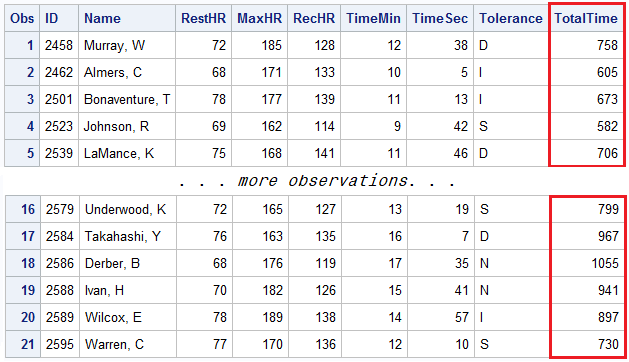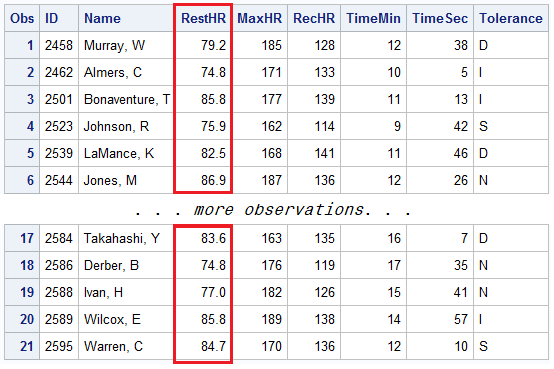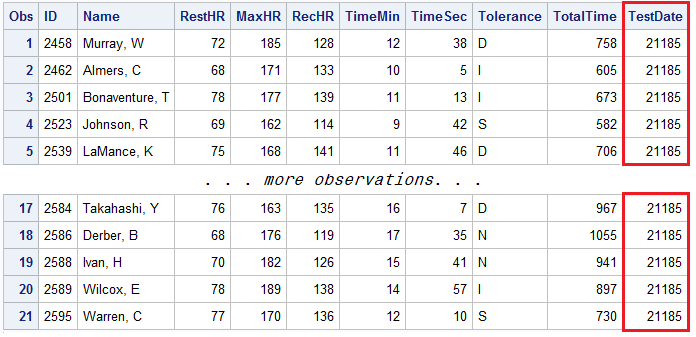Creating Variables
Assignment Statements
Use
an assignment statement in any DATA step in order to modify existing
values or create new variables.
|
Syntax, assignment statement:
variable=expression;
Tip:The assignment statement is
one of the few SAS statements that do not begin with a keyword.
|
For example, here is
an assignment statement that assigns the character value
Toby
Witherspoon to the variable Name: Name='Toby Witherspoon';
SAS Expressions
You use
SAS expressions in assignment statements and many other SAS programming
statements to do the following:
-
transform variables
-
create new variables
-
conditionally process variables
-
calculate new values
-
assign new values
An expression is a sequence
of operands and operators that form a set of instructions.
-
Operands are variable names or constants. They can be numeric, character, or both.
-
Operators are special-character operators, grouping parentheses, or functions.
Using Operators in SAS Expressions
Use the following arithmetic
operators to perform a calculation.
|
Operator
|
Action
|
Example
|
Priority
|
|---|---|---|---|
|
-
|
negative prefix
|
negative=-x; |
1
|
|
**
|
exponentiation
|
raise=x**y; |
1
|
|
*
|
multiplication
|
mult=x*y; |
2
|
|
/
|
division
|
divide=x/y; |
2
|
|
+
|
addition
|
sum=x+y; |
3
|
|
-
|
subtraction
|
diff=x-y; |
3
|
The order of operation
is determined by the following conditions:
-
Operations of priority 1 are performed before operations of priority 2, and so on.
-
Consecutive operations that have the same priority are performed in this order:
-
from right to left within priority 1
-
from left to right within priority 2 and 3
-
-
You can use parentheses to control the order of operations.
Note: When a value that is used
with an arithmetic operator is missing, the result of the expression
is missing. The assignment statement assigns a missing value to a
variable if the result of the expression is missing.
Use the following comparison
operators to express a condition.
|
Operator
|
Meaning
|
Example
|
|---|---|---|
|
= or eq
|
equal to
|
name='Jones, C.' |
|
^= or ne
|
not equal to
|
temp ne 212 |
|
> or gt
|
greater than
|
income>20000 |
|
< or lt
|
less than
|
x=5000 x<8000 |
|
>= or ge
|
greater than or equal
to
|
x=5000 x>=2000 |
|
<= or le
|
less than or equal to
|
pulse le 85 |
Use logical operators to link
a sequence of expressions into compound expressions.
|
Operator, symbol
|
Description
|
|---|---|
|
AND or &
|
and, both. If both expressions
are true, then the compound expression is true.
|
|
OR or |
|
or, either. If either
expression is true, then the compound expression is true.
|
Note: In SAS, any numeric value
other than 0 or missing is true, and a value of 0 or missing is false.
Therefore, a numeric variable or expression can stand alone in a condition.
-
0 = False
-
. = False
-
1 = True
Examples: Assign Variables
Example 1: Create a New Variable
The
assignment statement in the DATA step below creates a new variable,
TotalTime, by multiplying the values of TimeMin by 60 and then adding
the values of TimeSec.
data work.stresstest;
set cert.tests;
TotalTime=(timemin*60)+timesec;
run;
proc print data=work.stresstest;
run;Output 9.1 Assignment Statement Output (partial output)

Example 2: Re-evaluating Variables
In the following example,
the assignment statement contains the variable RestHR, which appears
on both sides of the equal sign. This assignment statement evaluates
each observation to redefine each RestHR observation as 10% higher.
When a variable name appears on both sides of the equal sign, the
original value on the right side is used to evaluate the expression.
The result is assigned to the variable on the left side of the equal
sign.
data work.stresstest;
set cert.tests;
resthr=resthr+(resthr*.10);
run;
proc print data=work.stresstest;
run;Output 9.2 PROC PRINT Output of Work.StressTest (partial output)

Date Constants
You can assign date values to variables
in assignment statements by using date constants. SAS converts a date
constant to a SAS date. To represent a constant in SAS date form,
specify the date as 'ddmmmyy' or 'ddmmmyyyy',
immediately followed by a D.
|
Syntax, date constant:
'ddmmmyy'd
'ddmmmyy'd
Tip:Be sure to enclose the date
in quotation marks.
|
Tip
You can also use SAS time
constants and SAS datetime constants in assignment statements.
Time='9:25't; DateTime='18jan2018:9:27:05'dt;
Example: Assignment Statements and Date Values
In the following program,
the second assignment statement assigns a date value to the variable
TestDate.
data work.stresstest;
set cert.tests;
TotalTime=(timemin*60)+timesec;
TestDate='01jan2015'd;
run;
proc print data=work.stresstest;
run;Notice how the values
for TestDate in the PROC PRINT output are displayed as SAS date values.
Output 9.3 PROC PRINT Output of Work.StressTest with SAS Date Values (partial
output)

You can use a FORMAT
statement in the PROC PRINT step to modify the TestDate values and
change them to another format. To apply formats
to your output, see SAS Formats and Informats.
Last updated: August 23, 2018
..................Content has been hidden....................
You can't read the all page of ebook, please click here login for view all page.
